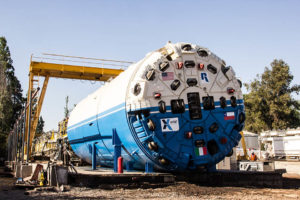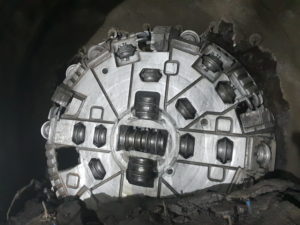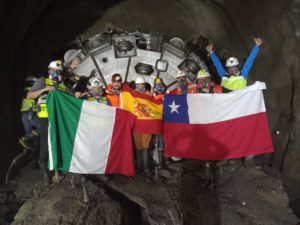新闻及资讯
Robbins Crossover holes through in the Andes
A Robbins 4.6 m (15.1 ft) diameter Crossover machine holed through in the Andes Mountains of Chile in the last quarter of 2021. The XRE TBM bored a 3.3 km (2.1 mi) long tunnel for Chile’s Los Condores Hydroelectric Power Project (HEPP) and project owner Enel.

The Robbins Crossover (XRE) TBM bored a 3.3 km (2.1 mi) long tunnel through the Chilean Andes.
A dedicated team, including three Robbins Field Service personnel, guided the machine to breakthrough in conditions including tuff, sandstone, breccia, and conglomerate with sections of high-pressure water inflows. Ground cover reached up to 450 m (nearly 1,500 ft) above the tunnel with rock strengths maxing out at 60 MPa UCS. “Robbins Field Service was an important part of the success of the excavation, evaluating continuous improvements in the machine and correcting faults,” said Ricardo Riveros Puratic, Project Engineer for Enel.
For Riveros Puratic, Crossover machines make sense despite the challenging conditions: “Towards the end, [the TBM] exceeded expectations. Crossover TBMs are suitable for Andean geology of sedimentary and volcanic type, where there is a great range of rock strengths and hydrogeological conditions.” Maximum advance rates topped out at 605.8 m (1,988 ft) in one month and 212.8 m (698.2 ft) in one week.

Despite challenging mixed ground and fault zones, the Robbins TBM achieved advance rates of up to 605.8 m (1,988 ft) in one month.
The Crossover machine featured a heavy duty, centrally mounted screw conveyor for the duration of the drive. The TBM remained in a hard rock configuration with muck chute installed, along with paddles, bucket lips, scrapers and disc cutters on the cutterhead. However, “75% of the excavation was performed using the main drive gearboxes in high torque configuration (EPB or low speed mode). We never physically changed the cutterhead or screw conveyor to EPB mode,” said Omar Alvarez, Robbins field service site manager at Los Condores.
High-pressure ground water inflows were the key challenge of the project. “When we started the excavation, we used dewatering hoses to reduce the water into the cutterhead during the excavation,” said Alvarez. Water pressures rose whenever the TBM stopped, however. “During the segment ring installation, we stopped the water from draining through the rear shield drilling ports and we closed the screw conveyor rear gate. We reached 7+ bar in the cutterhead earth sensors.”
“We bored in places with 5,500+ liters (1,500 gal) /min, making back-fill grout injection behind the concrete segments a challenge. We decided not to use the grout injection through the tail shield ports, but instead injected grout directly through the concrete segment with hoses. This approach was more flexible and reduced the need for reinjections,” said Alvarez.

Robbins Field Service and dedicated crew guided the XRE TBM through challenging conditions including water inflows of 5,500+ liters/min.
With multiple triumphs and lessons learned during tunneling, Alvarez reflected on the breakthrough: “I’m proud to be part of a team that finished a tunnel in the Andes Mountains.” Once brought online, the Los Condores HEPP, located in the mountainous southern Maule region, will have an annual generating capacity of 150 MW.

 Close
Close  Menu
Menu 